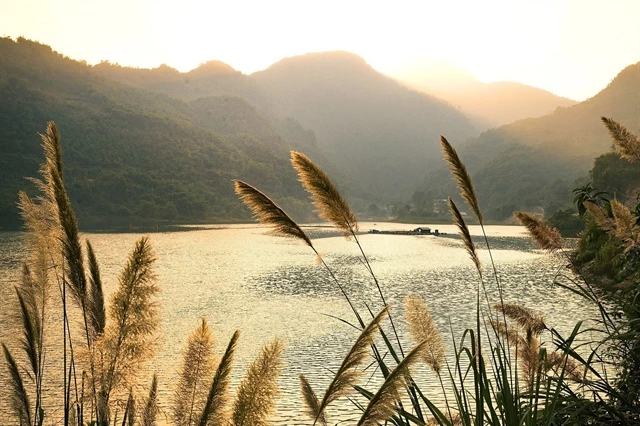
Hoa Binh Reservoir, about 70km from Hanoi, is the body of water created by the Hoa Binh Dam in Da River – Vietnam’s largest hydroelectric dam.
Stretching through several communes in five districts and Hoa Binh City, it is also the biggest reservoir in Southeast Asia.
Hundreds of hills and mountains that once dominated the area were swallowed by the rising water, except their summits which are now islands in the lake. That is why the lake has been dubbed "Terrestrial Ha Long Bay in the Mountains”.
 The lake possesses a poetic and pristine landscape, along with the rich culture of different ethnic groups living in the surrounding area. — VNA/VNS Trọng Đạt
The lake possesses a poetic and pristine landscape, along with the rich culture of different ethnic groups living in the surrounding area. — VNA/VNS Trọng Đạt
With its poetic, pristine landscape, along with the rich culture of different ethnic groups living nearby, Hoa Binh Lake has been set by the provincial authority as a key tourism destination to develop the province’s tourism.
 Hòa Bình reservoir is the body of water created by the Hòa Bình Dam in Đà River –Việt Nam’s largest hydroelectric dam. — VNA/VNS Trọng Đạt
Hòa Bình reservoir is the body of water created by the Hòa Bình Dam in Đà River –Việt Nam’s largest hydroelectric dam. — VNA/VNS Trọng Đạt
Visiting the lake, tourists not only can enjoy the picturesque scenery but also the tale of Thac Bo Goddess who helped Emperor Le Loi to defeat foreign invaders in the 15th century as well as built up a better life for local Muong ethnic people. When she died, Emperor Le Loi asked local people to build a temple to worship her. The temple now is a very popular religious tourist destination for tourists.
 A boat seen at sunset on Hòa Bình Lake. — VNA/VNS Photo Trọng Đạt
A boat seen at sunset on Hòa Bình Lake. — VNA/VNS Photo Trọng Đạt
Hoa Binh is also home to several ethnic groups including Muong, Thai, Tay, Dao, and Mong, of which Muong is the largest community (64 % of provincial population).
Making the most of the rich yet diversified ethnic culture, the province has made efforts over the years to develop community-based tourism.
 Tourist boats dock at a wharf in front of the Temple of Thác Bờ Goddess by Hòa Bình Lake. — VNA/VNS Photo Trọng Đạt
Tourist boats dock at a wharf in front of the Temple of Thác Bờ Goddess by Hòa Bình Lake. — VNA/VNS Photo Trọng Đạt
Several community-based tourism villages have been praised by tourists, such as the Ngoi Hamlet in Suoi Hoa Commune, Tan Lac District; Mo Hamlet in Binh Thanh Commune, Cao Phong District; Ke Hamlet in Hien Luong Commune, and Da Bia Hamlet in Tien Phong Commune in Da Bac District.
In 2022, the province greeted about 3 million visitors, of which, 100,000 were foreigners. The total revenue from tourism reached VND3.1 trillion (about US$125 million).
Viet Nam News
Asia News Network


